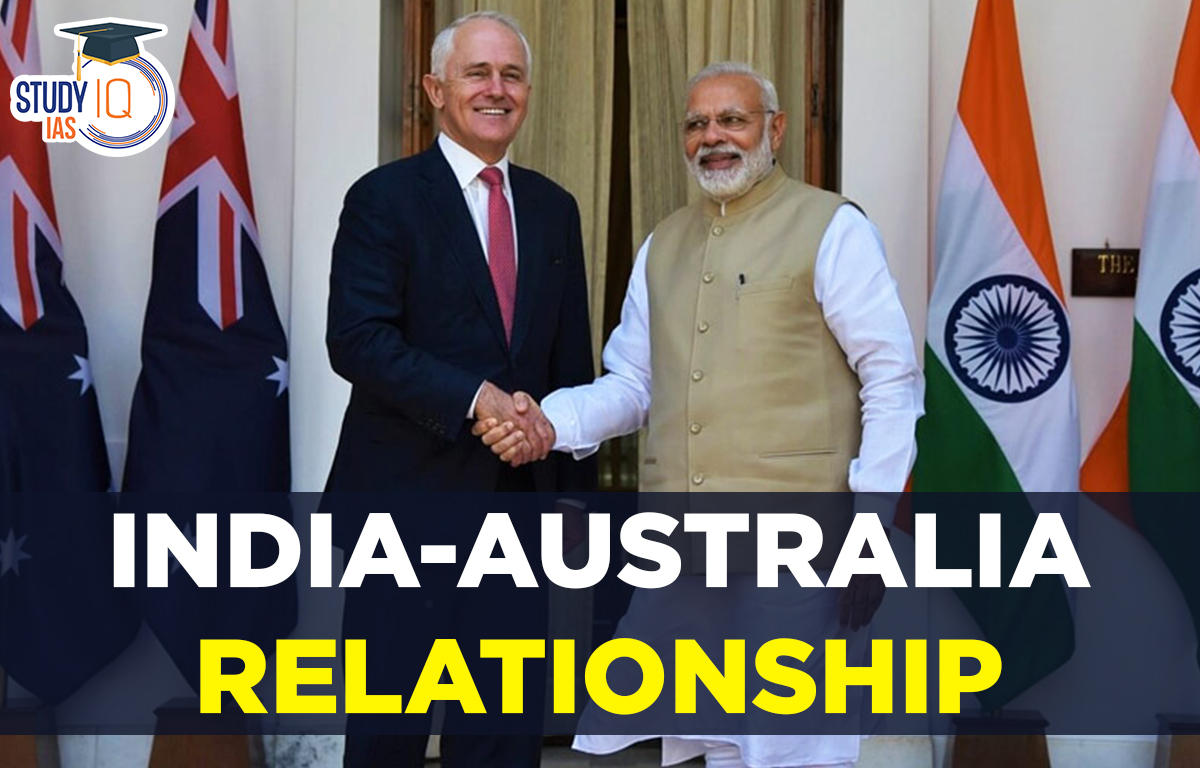Table of Contents
Context: Recently, Australian Prime Minister began his four-day visit to India from Ahmedabad.
Background of India-Australia Relationship
- At the India-Australia Leaders’ Virtual Summit in June 2020, Indian Prime Minister and Australian Prime Minister elevated the bilateral relationship from the Strategic Partnership concluded in 2009 to a Comprehensive Strategic Partnership (CSP).
- At the 2nd India-Australia Virtual Summit in March 2022, several key announcements were made, including on a Letter of Intent on Migration and Mobility Partnership Arrangement to foster the exchange of skills, and a Letter of Arrangement for Educational Qualifications Recognition to facilitate the mobility of students and professionals.
- Common Trait in Relationship: Shared values of pluralistic, Westminster-style democracies, Commonwealth traditions, a free press, an independent judicial system, and English language serve as the foundation for closer co-operation.

India-Australia Cooperation
- Economic cooperation: The Economic Cooperation Trade Agreement (ECTA) entered into force in December 2022, and has resulted in an immediate reduction of duty to zero on 96% of Indian exports to Australia in value (that is 98% of the tariff lines) and zero duty on 85% of Australia’s exports (in value) to India.
- Bilateral trade was US$ 27.5 billion in 2021; with ECTA, there is potential for it to reach around US$ 50 billion in five years.
- India is Australia’s sixth largest trading partner.
- People-to-people ties: India is one of the top sources of skilled immigrants to Australia.
- As per the 2021 Census, around 9.76 lakh people in Australia reported their ancestry as Indian origin, making them the second largest group of overseas-born residents in Australia.
- Education: The Mechanism for Mutual Recognition of Educational Qualifications (MREQ) was signed on March 2 this year. This will facilitate mobility of students between India and Australia.
- More than 1 lakh Indian students are pursuing higher education degrees in Australian universities, making Indian students the second largest cohort of foreign students in Australia.
- Australia-India Education Qualification Recognition Mechanism: It means that degrees obtained in Australia will now be recognised in India, and, vice-versa.
- Deakin University, one of Australia’s top educational institutions, will be the first foreign university to set up an international branch campus at GIFT (Gujarat International Finance Tec) City in Gandhinagar.
- Defence cooperation: The 2+2 Ministerial Dialogue was held in September 2021.
- Mutual Logistics Support Agreement (MLSA) was concluded during the Virtual Summit in June 2020, and the two militaries held several joint exercises in 2022.
- Australia will host military operations with India, Japan, and the US in the “Malabar” exercises off the coast of Perth in August, and has invited India to join the Talisman Sabre exercises later this year.
- Security and defence cooperation between New Delhi and Canberra is increasingly aimed at upholding freedom of navigation and creating a “strategic equilibrium” in the Indo-Pacific maritime space.
- Clean energy: The countries signed a Letter of Intent on New and Renewable Energy in February 2022 which provides for cooperation towards bringing down the cost of renewable energy technologies, especially ultra low-cost solar and clean hydrogen.
- In March 2022, India announced matching funds of AUD 10 million for Pacific Island Countries under Infrastructure for Resilient Island States (IRIS) and of AUD 10 million for Pacific Island Countries under International Solar Alliance (ISA).
- China factor: Both Australia and India support a rules-based international order and are partners in seeking to forge regional institutions in the Indo-Pacific which are inclusive, promote further economic integration. Both have been assessing the Chinese challenge since 2013.
- Australia in 2018 banned Chinese telecom firm Huawei from the 5G network.
- It called for an inquiry into the origins of Covid-19, and slammed China’s human rights record in Xinjiang and Hong Kong.
- India has been facing an aggressive Chinese military along the border.
- The countries’ participation in Quad is an example of their convergence of interests, based on shared concerns.
Conclusion
- Two countries are important partners in the Indo-Pacific and cooperate closely in a wide range of sectors.
- India’s closer engagement with Australia is a crucial building block of its evolving outreach to the bustling India-Pacific region.
- As India welcomes Albanese this week, “Cricket, Commonwealth and Curry” should make way for “China, Climate and Critical Tech.”
QUAD
- It is four-country coalition, comprising United States, Japan, India, and Australia.
- It is a common platform of standing for a rules-based order, protecting freedom of navigation, and promoting democratic values in the region.


 SSC Stenographer 2024 Notification Out a...
SSC Stenographer 2024 Notification Out a...
 IB SA MTS Final Result 2024 Out at mha.g...
IB SA MTS Final Result 2024 Out at mha.g...
 Model Skill Loan Scheme, Eligibility, Re...
Model Skill Loan Scheme, Eligibility, Re...

















